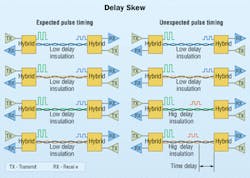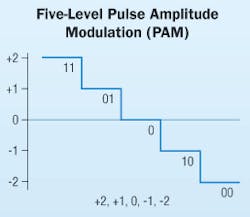The 1000Base-TX standard will pave the way for lower cost gigabit-speed systems.
We often hear the mantra of the cable industry-"future proof your cabling system". But with 1000Base-T (Gigabit Ethernet) designed to work over existing Category 5 and 5e systems, is there a solid economic justification to deploy Category 6 cabling? In short, yes. Category 6 is not only the best choice to assure sufficient headroom for real-world implementation of Gigabit Ethernet, it also provides the necessary foundation for lowering the total system cost of Gigabit Ethernet.
To understand why Category 6 cabling will soon become a critical path in the progression of Ethernet, let's first examine the path our industry has taken. Dr. Robert Metcalf invented Ethernet while working for Xerox in 1976. The technology was refined, and a second generation-called Ethernet II, and often referred to as DIX after its corporate sponsors Digital, Intel and Xerox-was widely used. While Ethernet's humble beginnings were only 2.94 Mbits/sec, it soon evolved into a 10 Mbits/sec network protocol that quickly surpassed token ring architectures. Engineers may argue about the technical advantages of Ethernet, but its true initial advantage was in its economics.
The acceptance of Ethernet by chip manufacturers led to lower cost network interface cards (NICs), which in turn fueled end user acceptance. More than 22 years ago, Ethernet became the de facto LAN protocol everywhere. The flexibility of Ethernet design allowed for the development of Fast Ethernet (100 Mbits/sec) in 1995, with complete retention of the original frame structure of 10Base-T.
The Gigabit Ethernet NIC market is shaping up to be another 10/100 market, and most likely will take the form of a 10/100/1000 product offering with auto-sensing and auto-configuration for any of the speeds supported by the LAN. The key question is: When will the 10/100/1000 NIC price fall to a 50% premium over 10/100 NICs? When that happens, we would argue that the rate of market adoption of the "tri-mode" NIC will accelerate quickly. Currently, 1000 Mbits/sec transceiver chip prices for 1000Base-T are in the $17 range. This cost is a significant premium to the current 10/100 Mbits/sec transceiver cost, and the gap is not expected to shrink significantly anytime soon.
100Base-T vs. 1000Base-TX
All this history and the current dynamics bring us to 1000Base-TX. Last year, the Telecommunications Industry Association/ Electronic Industries Alliance (TIA/EIA) approved TIA/EIA-854 Full Duplex Ethernet Specification for 1000 Mbits/sec Operation Over Balanced Twisted-Pair Cabling, with little fanfare. While this new specification does nothing to improve the throughput capacities of Gigabit Ethernet, its design allows for significant reductions in the complexity and quantity of chips needed for Gigabit Ethernet NICs. The technical differences of 1000Base-TX, when compared to 1000Base-T, will translate to lower cost NICs for end users.
The price of 1000Base-TX chips is expected to fall below that of 1000Base-T chips late this year, with a price gap that will continue to widen thereafter. The price of NICs and Ethernet switches, being directly correlated to the chip cost, will correspondingly favor 1000Base-TX technology. Consequently, the marketplace is expected to embrace 1000Base-TX NICs (based on TIA/EIA-854) over 1000Base-T NICs (based on IEEE 802.3ab), and the rapid acceptance of 10/100/1000 Mbits/sec NICs over 10/100 Mbits/sec NICs may start as early as 2003.
There are several reasons why 1000Base-T equipment will be made obsolete by an improved technology that is less expensive, uses less power, and is more compact. The two standards specifying Gigabit Ethernet have been issued by different standards organizations. The earlier of the two documents, issued in 1999, is the IEEE 802.3ab specification and applies to 1000Base-T. The second standard published was TIA/EIA-854. Both standards use all four pairs in the cables, but each employs a different transmission technique and bit rate-802.3ab (1000Base-T) calls for a 250 Mbits/sec bit rate applied bi-directionally on each of the four pairs, in full duplex; TIA/EIA-854 (1000Base-TX) calls for a 500 Mbits/sec bit rate applied unidirectionally on each pair so that the transmit path is physically separated from the receive path.
The 1000Base-T configuration adds a significant amount of complexity and cost because of the bi-directional transmission (two-way transmission on a single pair). This design requires the use of hybrids to separate the transmission path from the receive path. It also requires high-powered digital signal processors (DSPs) to cancel the echoes generated by the near and far-end hybrids. In addition, near-end and far-end crosstalk must also be filtered out from already-complex signals. This puts a significant burden on the electronics in terms of complexity, chip size, and power consumption.
All of these factors equate to higher costs. In contrast, the design of 1000Base-TX does not require hybrids, nor does it necessitate echo cancellation. Consequently, the design of 1000Base-TX allows for its electronics to be much less expensive than comparable 1000Base-T electronics.
Addressing the installed base
With the clear advantages of 1000Base-TX, what is driving the use of 1000Base-T? One factor is that the bit rate is only half that of 1000Base-TX. The architects of 802.3ab intentionally designed it this way to ensure that Gigabit Ethernet would run on existing Category 5 and 5e cabling systems, which make up the majority of installed LANs today. While it is a noble goal for a technology to accommodate the installed base, in this case, it leads to compromises and economic disadvantages for two classes of end users:
- Those with marginal or inferior cabling that need to upgrade it anyway;
- Those implementing new LANs without legacy cabling.
As for users with marginal or inferior cabling systems, a 2001 survey by Sage Research Inc. (www.sageresearch.com) indicates that 87% of companies have Category 5 cabling installed in their horizontal networks. While much of this installed base of Category 5, and even Category 5e, may be perfectly capable of transmitting Gigabit Ethernet, much of it will not. The reason is delay skew-the variation between arrival times of the signals on different pairs.
Since Gigabit Ethernet requires the use of all four pairs in the cable, delay skew can be a concern if all four pairs do not meet the proper specification. When different insulating materials are used on the pairs, the signals' velocity of propagation will vary according to the materials used. Therefore, by using cables that have different insulating materials on each pair, the delay skew may be significant enough that a 250 Mbits/sec transmission protocol will not work properly.
Over the past several years, there have been shortages of insulating materials, specifically fluoropolymers, required to meet Category 5 and 5e performance and plenum ratings. During times of fluoropolymer shortages, some manufacturers insulated only two pairs in the cable with fluoropolymers and substituted a less expensive, more readily available material on the other two pairs. This choice allowed manufacturers to continue producing and selling significant quantities of Category 5 and 5e cables during times of critical material shortages.
While these cables may not have even met the Category 5/5e specification for delay skew, that was not a problem for Ethernet and Fast Ethernet because those systems only used two pairs-the same two pairs insulated with fluoropolymers. These same cables, however, could pose a technical problem for Gigabit Ethernet, with specifications and electronics requiring that all four pairs have the same velocity of propagation. To run Gigabit Ethernet, customers with this latent delay skew problem in their cabling systems will have to consider replacing their cabling infrastructure.
For a user who is installing a new network for Gigabit Ethernet, let's assume the user is choosing twisted-pair rather than optical-fiber cabling. It is acknowledged that optical-fiber cabling is a viable option and likely will receive strong consideration by many users. But, for this discussion, we want to weigh Category 5e versus Category 6 as Gigabit Ethernet infrastructures.
The 1000Base-TX system configuration reduces much of the complexity and power consumption required by 1000Base-T, which translates into lower cost electronics. This reduced complexity is achieved by taking advantage of the superior transmission characteristics of Category 6 cabling systems. As such, the TIA/EIA-854 specification requires Category 6 cable be installed to support the doubling of bit rates on each pair to 500 Mbits/sec.
To understand why Category 6 cabling is required for 1000Base-TX, let's examine the signaling design of this standard versus that of 1000Base-T. While the bit rate on 1000Base-TX (500 Mbits/sec) is twice that of 1000Base-T (250 Mbits/sec) and five times that of Fast Ethernet 100Base-TX (100 Mbits/sec), all of these systems use the same symbol rate, or signaling rate.
Better than binary
A five-level pulse amplitude modulation (PAM) technique is employed with 1000Base-TX, which transmits two bits for each change in signal state. Five signal, or amplitude, levels are represented in the line code. Two bits of information are assigned to each level, in what is sometimes called di-bit encryption. Five-level PAM provides better bandwidth use than binary signaling, where each transmitted signal represents a single bit, such as a 0 or a 1. Each transmitted symbol represents one of five different levels corresponding to different voltage levels (+2, +1, 0, -1, -2). Each symbol represents two bits of information, where four of the levels are used for data and the fifth is used for forward error correction.
Five-level PAM reduces the signaling rate by a factor of two, and correspondingly, the signal bandwidth and symbol rate are also reduced by the same factor. The signaling rate in the case of five-level PAM is 250 megabaud (MBd) per second, but the bit rate is actually 500 Mbits/sec. Compare this with 1000-Base-T's 125 MBd rate and an effective bit rate of 250 Mbit/sec on each pair. The "cost" of implementing five-level PAM is the requirement for better signal-to-noise performance. Category 6 cabling systems provide this necessary increase in signal-to-noise performance, thereby re ducing design complexity requirements within the transceivers.
In the end, properly configured 1000Base-T and 1000Base-TX LANs should provide the same result: Successful Gigabit Ethernet. The important factor separating the two is simply cost. Clearly, the cost of a Category 6 cabling system (which is required by 1000Base-TX) is more than the cost of a Category 5e cabling system. But what is the difference in the total system cost?
Several analyses have been done in the recent past to break down the costs of a LAN. These analyses show that the material cost of the cabling infrastructure typically accounts for 2 to 3% of the total network cost. Let's assume 3% for this comparison. In contrast, the cost of active electronics typically accounts for 10% or more of the total cost of the same network. Let's assume 10%. Now, assuming a 50% premium for Category 6 cabling materials over Category 5e, the cost of 1000Base-TX active electronics would need to be 85% of the cost of 1000Base-T electronics for the total system costs to be equal. And, it is likely that 1000Base-TX electronics will sell for less than 85% of 1000Base-T electronics as early as next year-and most certainly in the long run.
We should also expect the cost premium of Category 6 cabling to lessen, which will make expansions to the original LAN more favorable to a 1000Base-TX-based network. Based on these estimates, a Category 6 cabling system will be a more cost-effective choice for any organization that is not immediately deploying Gigabit Ethernet but has plans to do so one year or more from now.
Mark Farrant is director of new business technology, and Tim Waldner is senior vice president of marketing for Superior Essex (www.superioressex.com).
null


